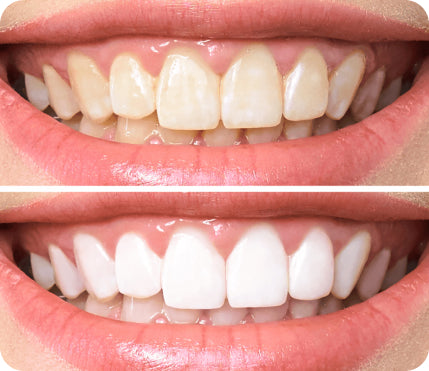
All products are certified by dental expert Dr. Greg Grillo
Hutchinson teeth are a fascinating yet unsettling dental condition that can tell a unique story about a person's health history.
These teeth are not just intriguing to look at, but they also offer insights into a devastating disease that has plagued humanity for centuries - syphilis. A total of 133,945 cases of syphilis at all stages have been reported in recent years in the United States alone, with an alarming annual increase of 6.8%.
In order to maintain proper oral and overall health, it is vital to gain a thorough understanding of the causes, symptoms, treatment options, and preventive measures associated with this dental issue.
Why Is It Called Hutchinson Teeth? An overview
The term Hutchinson teeth have its origins traced back to Sir Jonathan Hutchinson, a renowned British physician who was the first to describe this peculiar dental condition in children suffering from congenital syphilis.
The name is derived from the distinct appearance of the affected upper incisor teeth, which display an abnormal development as a result of the bacterial infection that is transmitted from an infected pregnant mother to her unborn child during pregnancy.
Typically, Hutchinson Teeth are characterized by certain telltale signs, such as a notched, peg-shaped morphology and a widely spaced arrangement. These features make the condition easily distinguishable and recognizable, setting it apart from other dental abnormalities.
Causes Of Hutchinson Teeth
Hutchinson Teeth primarily stem from an infection by the bacterium treponema pallidum, which causes congenital syphilis in children.
This occurs when an infected mother passes the bacteria to her baby during pregnancy, resulting in a range of detrimental effects on the child's development – one of which is the abnormal formation of the upper incisors.
In addition to their distinct shape and spacing, Hutchinson teeth in toddlers may also exhibit additional symptoms, such as the following:
- Inflammation and gum swelling around the affected teeth
- Increased sensitivity to hot, cold, or sweet stimuli
- Dental pain or discomfort
- Difficulty biting and chewing food properly
Although congenital syphilis is the primary cause of Hutchinson teeth, it should be noted that other factors can contribute to abnormal tooth development. These can include malnutrition, exposure to certain toxins during pregnancy, or other medical conditions that affect tooth formation.
Pictures Of Hutchinson Teeth
Here are some images that illustrate Hutchinson teeth. Despite ongoing advances in understanding and treatment, Hutchinson's teeth serve as a reminder of the detrimental effects of syphilis.
This disorder is typically characterized by notched, peg-shaped, and widely spaced teeth.
Symptoms Of Hutchinson Teeth
While the most noticeable indication of Hutchinson teeth relates to the distinctive look of the impacted person's top front teeth, individuals with congenital syphilis, which is the root cause of Hutchinson teeth, may also encounter various other symptoms.
These symptoms can vary greatly in severity, and some of the most commonly observed ones include:
- Distinctly notched, peg-shaped upper incisors
- Abnormally wide spacing between teeth
- Unusual tooth alignment, often leading to crowding of teeth
- A higher propensity for tooth decay and cavities
- Weakened tooth enamel, making teeth more susceptible to damage
Because early intervention is crucial in managing congenital syphilis and its associated symptoms, it is of utmost importance to consult with a dentist or healthcare professional if any of these signs are present.
This is especially true if these dental symptoms are accompanied by other indications of congenital syphilis, such as skin lesions, an enlarged liver or spleen, or abnormalities in the skeletal structure.
By becoming more familiar with the causes, symptoms, and appearance of Hutchinson teeth, you can take the necessary steps to ensure proper dental care for yourself or your loved ones. Early diagnosis and treatment of this condition can make a significant difference in the overall health and well-being of those affected.
How To Treat Hutchinson Teeth
While the abnormal appearance of Hutchinson teeth cannot be reversed or corrected, dental professionals employ various treatment options to manage the symptoms and prevent further complications.
Dental Crowns
A dental crown, also known as a tooth-shaped cap, is a versatile treatment option that is cemented onto a damaged tooth to restore its original shape, size, and appearance.
Dental crowns can greatly enhance the look and function of Hutchinson Teeth by providing a more even and appealing appearance. The materials used for dental crowns can include ceramic, porcelain, resin, or metal alloys, each offering its unique benefits and suitability for various dental situations.
Procedure For Dental Crowns
The process of getting a dental crown usually involves a few visits to the dentist. The dentist will assess the affected tooth and prepare it by removing any decay and reshaping the tooth's structure.
Then, an impression of the treated tooth will be taken and sent to a dental laboratory for the fabrication of the crown. You may receive a temporary crown to protect your tooth while you wait for your permanent crown to be ready.
Once the permanent crown is ready, your dentist will ensure it fits well, make necessary adjustments, and then cement it in place.
Dental Bridges
In cases where a patient with Hutchinson teeth is missing any teeth or requires extraction due to severe damage or decay, dental bridges may be an appropriate solution.
A dental bridge is a false tooth or teeth, also known as pontics, positioned between two healthy teeth (abutment teeth). They act as anchors and support the pontics to fill the gap created by the missing tooth or teeth.
Procedure For Dental Bridges
Like dental crowns, getting a dental bridge usually takes multiple dentist appointments. After assessing the teeth involved, the dentist will prepare the abutment teeth by removing a portion of enamel to allow room for a crown.
Similar to the dental crown process, an impression of your teeth will be sent to a dental lab for the creation of the dental bridge.
You might receive a temporary bridge to protect your teeth while you wait for your permanent bridge. Upon your next visit, your dentist will ensure the permanent bridge fits correctly and cement it in place.
Teeth Fillings
In instances where children with Hutchinson teeth experience decay due to poor tooth enamel, dental fillings can help restore the affected teeth by sealing off the cavity and preventing further decay.
Fillings are available in various materials, such as amalgam, composite resin, gold, and porcelain, and your dentist will recommend the most suitable option based on your individual needs.
Procedure For Teeth Fillings
Teeth filling procedures typically require only one visit to the dentist. The dentist will first administer local anesthesia to numb the area around the affected tooth.
Next, the decayed portion of your tooth will be removed and the area cleaned. Finally, the dentist will fill the cavity with the chosen filling material and polish it for a smooth finish.
Teeth Braces
For patients with Hutchinson teeth who develop crowding and misalignment issues, orthodontic treatments, such as braces, can help progressively shift teeth to their correct positions, improving dental function and appearance significantly.
Procedure For Teeth Braces
Orthodontic treatment starts with a consultation, during which a dentist or orthodontist will assess your teeth and discuss your options.
After deciding on the right type of braces for your situation (traditional metal braces, ceramic braces, lingual braces, or clear aligners), your orthodontic professional will install them and periodically adjust them during follow-up appointments. The duration of orthodontic treatment can range from several months to a few years, depending on the severity of the dental problem.
Treating Hutchinson teeth involves addressing the primary cause of congenital syphilis and improving dental health with various dental procedures. Your dentist will advise you on the most suitable treatment combination to achieve optimum dental health and an aesthetically pleasing smile.
Preventing Hutchinson Teeth
Preventing Hutchinson teeth primarily involves early detection and treatment of syphilis in pregnant women. Adequate prenatal care and appropriate diagnostic testing are crucial steps in managing syphilis during pregnancy.
Importance Of Prenatal Care
Prenatal care is absolutely crucial when it comes to identifying and managing syphilis during pregnancy. Pregnant women should speak with their healthcare providers about getting tested for syphilis at the first prenatal visit.
Through appropriate screening and administration of antibiotics, particularly Penicillin G, the risk of transmitting the infection to the unborn child can be considerably reduced. This can ultimately prevent the emergence of Hutchinson teeth and other associated complications stemming from congenital syphilis.
Dental Health And Nutrition For Prevention
Maintaining good oral hygiene, having regular dental check-ups, and following a healthy diet also play vital roles in preventing dental problems such as tooth decay and cavities.
Routinely practicing dental hygiene, including brushing twice daily with fluoride toothpaste, flossing, and using mouthwash, can help lower the likelihood of developing complications related to Hutchinson teeth or other dental issues.
Adopting a well-balanced diet rich in vitamins and minerals, especially calcium, phosphorus, and vitamin D, is essential for strengthening teeth and maintaining optimal oral health. These nutrients can be found in dairy products, leafy green vegetables, fish, nuts, and seeds.
By taking proactive measures, individuals can protect themselves and their children from the adverse effects of Hutchinson teeth and maintain a healthy smile, as well as overall health, for years to come.
Final Thoughts
Hutchinson teeth are a unique dental condition that warrants proper understanding and awareness. Early detection and treatment of syphilis during pregnancy, combined with proper dental care and a nutritious diet, can go a long way in preventing this condition and ensuring the overall health of both the mother and unborn child.
If you have any concerns relating to Hutchinson Teeth or congenital syphilis, it is necessary to consult a qualified healthcare professional for guidance and appropriate treatment measures.
By being well-informed about the causes, symptoms, treatment options, and preventive measures, you can ensure better oral health for yourself and your child.
Find out more about Hutchinson teeth by reading these frequently asked questions and their answers.
How Does Congenital Syphilis Affect The Teeth?
Congenital syphilis is a condition that occurs when a pregnant woman with syphilis passes the infection on to her unborn child. One of the dental manifestations of this condition is the development of Hutchinson teeth.
Hutchinson teeth occur because the infection spreads to the developing teeth of a baby in the womb, disrupting their normal development. This dental issue primarily affects the upper incisors, causing them to become notched, peg-shaped, and widely spaced. The abnormal appearance of these teeth is a result of disrupted tooth development during the fetal stage due to the syphilis infection.
Other dental problems that can arise due to congenital syphilis include the delayed eruption of teeth, enamel hypoplasia (a condition where the enamel is thin and underdeveloped), and gum inflammation.
What Do Hutchinson Teeth Look Like?
Hutchinson Teeth are easily distinguishable due to their unique and characteristic appearance. The upper incisors are predominantly affected, displaying notches and grooves along the cutting edge. Additionally, these teeth tend to have a peg-shaped, tapered form and are often spaced wider than normal.
In severe cases, Hutchinson teeth may be so severely malformed that they can't be saved and must be extracted.
Can A Child Develop Hutchinson Teeth Without Syphilis?
It is highly unlikely for a child to develop Hutchinson teeth without being exposed to syphilis. Hutchinson teeth are specifically associated with congenital syphilis, a sexually transmitted infection passed from an infected mother to her baby during pregnancy or childbirth.
However, there are other factors apart from syphilis that can lead to abnormal tooth development in children. These factors may include malnutrition or exposure to specific toxins during pregnancy.
Regardless of the cause, it is essential to seek medical and dental attention if a child shows signs of Hutchinson teeth or any dental abnormalities to identify the root cause and provide appropriate treatment.












